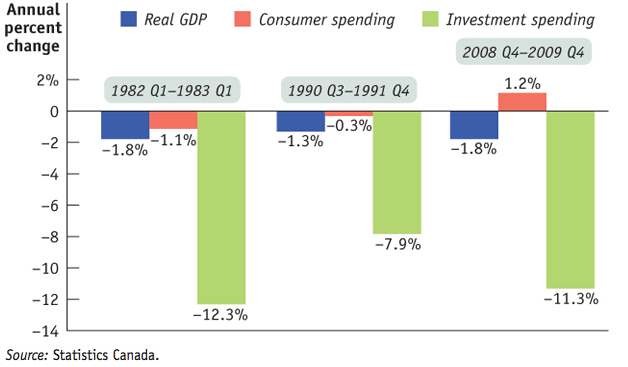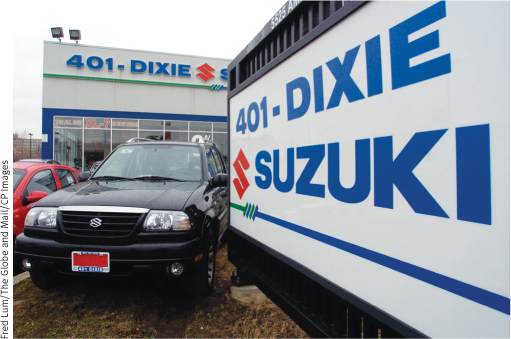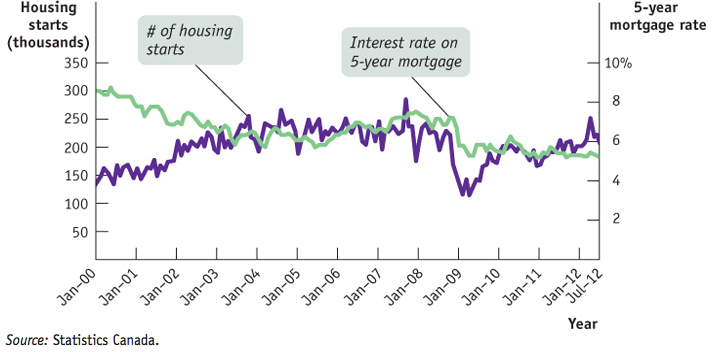11.3 Investment Spending
Although consumer spending is much larger than investment spending, booms and busts in investment spending tend to drive the business cycle. In fact, most recessions originate as a fall in investment spending. Figure 11-6 illustrates this point; it shows the annual percent change of investment spending and consumer spending in Canada, measured in real terms, during three recessions between 1980 and the present. As you can see, swings in investment spending are much more dramatic than those in consumer spending real GDP. In addition, due to the multiplier process, economists believe that declines in consumer spending are usually the result of a process that begins with a slump in investment spending. Soon we’ll examine in more detail how a slump in investment spending generates a fall in consumer spending through the multiplier process.

Source: Statistics Canada.
Planned investment spending is the investment spending that businesses intend to undertake during a given period.
Before we do that, however, let’s analyze the factors that determine investment spending, which are somewhat different from those that determine consumer spending. The most important ones are the interest rate and expected future real GDP. We’ll also revisit a fact that we noted in For Inquiring Minds in Chapter 10: the level of investment spending businesses actually carry out is sometimes not the same level as planned investment spending, the investment spending that firms intend to undertake during a given period. Planned investment spending depends on three principal factors: the interest rate, the expected future level of real GDP, and the current level of production capacity. First, we’ll analyze the effect of the interest rate.
The Interest Rate and Investment Spending
Interest rates have their clearest effect on one particular form of investment spending: spending on residential construction—
Interest rates also affect other forms of investment spending. Firms with investment spending projects will only go ahead with a project if they expect a rate of return higher than the cost of the funds they would have to borrow to finance that project. As we saw in Chapter 10 when the interest rate rises, fewer projects will pass that test, and as a result investment spending will be lower.
You might think that the trade-
So planned investment spending—
Expected Future Real GDP, Production Capacity, and Investment Spending
Suppose a firm has enough capacity to continue to produce the amount it is currently selling but doesn’t expect its sales to grow in the future. Then it will engage in investment spending only to replace existing equipment and structures that wear out or are rendered obsolete by new technologies (i.e., the depreciation of capital). But if, instead, the firm expects its sales to grow rapidly in the future, it will find its existing production capacity insufficient for its future production needs. So the firm will undertake investment spending to meet those needs. This implies that, other things equal, firms will undertake more investment spending when they expect their sales to grow.
Now suppose that the firm currently has considerably more capacity than necessary to meet current production needs. Even if it expects sales to grow, it won’t have to undertake investment spending for a while—
According to the accelerator principle, a higher growth rate of real GDP leads to higher planned investment spending, but a lower growth rate of real GDP leads to lower planned investment spending.
If we put together the effects on investment spending of growth in expected future sales and the size of current production capacity, we can see one situation in which we can be reasonably sure that firms will undertake high levels of investment spending: when they expect sales to grow rapidly. In that case, even excess production capacity will soon be used up, leading firms to resume investment spending.
What is an indicator of high expected growth of future sales? It’s a high expected future growth rate of real GDP. A higher expected future growth rate of real GDP results in a higher level of planned investment spending, but a lower expected future growth rate of real GDP leads to lower planned investment spending. This relationship is summarized in a proposition known as the accelerator principle. As we explain in the upcoming Economics in Action, in late 2008, when expectations of future real GDP growth turned negative, planned investment spending—
Inventories and Unplanned Investment Spending
Most firms maintain inventories, stocks of goods held to satisfy future sales. Firms hold inventories so they can quickly satisfy buyers—a consumer can purchase an item off the shelf rather than waiting for it to be manufactured. In addition, businesses often hold inventories of their inputs to be sure they have a steady supply of necessary materials and spare parts. At the end of the second quarter of 2012, the overall value of inventories in Canada was estimated at $8.9 billion (0.5% of GDP).
As we explained in Chapter 7, a firm that increases its inventories is engaging in a form of investment spending. Suppose, for example, that Canada’s auto industry produces 80 000 cars per month but sells only 70 000. The remaining 10 000 cars are added to the inventory at auto company warehouses or car dealerships, ready to be sold in the future. Inventory investment is the value of the change in total inventories held in the economy during a given period. Unlike other forms of investment spending, inventory investment can actually be negative. If, for example, the auto industry reduces its inventory over the course of a month, we say that it has engaged in negative inventory investment.
Inventory investment is the value of the change in total inventories held in the economy during a given period. It can be positive or negative.
To understand inventory investment, think about a manager stocking the canned goods section of a supermarket. The manager tries to keep the store fully stocked so that shoppers can almost always find what they’re looking for. But the manager does not want the shelves too heavily stocked because shelf space is limited and products can spoil. Similar considerations apply to many firms and typically lead them to manage their inventories carefully. However, sales fluctuate. And because firms cannot always accurately predict sales, they often find themselves holding more or less inventories than they had intended. These unintended swings in inventories due to unforeseen changes in sales are called unplanned inventory investment. They represent investment spending, positive or negative, that occurred but was unplanned.
Unplanned inventory investment occurs when actual sales are more or less than businesses expected, leading to unplanned changes in inventories.
So in any given period, actual investment spending is equal to planned investment spending plus unplanned inventory investment. If we let IUnplanned represent unplanned inventory investment, IPlanned represent planned investment spending, and I represent actual investment spending, then the relationship among all three can be represented as:
Actual investment spending is the sum of planned investment spending and unplanned inventory investment.


To see how unplanned inventory investment can occur, let’s continue to focus on the auto industry and make the following assumptions. First, let’s assume that the industry must determine each month’s production volume in advance, before it knows the volume of actual sales. Second, let’s assume that it anticipates selling 80 000 cars next month and that it plans neither to add to nor subtract from existing inventories. In that case, it will produce 80 000 cars to match anticipated sales.
Now imagine that next month’s actual sales are less than expected, only 70 000 cars. As a result, the value of 10 000 cars will be added to investment spending as unplanned inventory investment.
The auto industry will, of course, eventually adjust to this slowdown in sales and the resulting unplanned inventory investment. It is likely that it will cut next month’s production volume in order to reduce inventories. In fact, economists who study macroeconomic variables in an attempt to determine the future path of the economy pay careful attention to changes in inventory levels. Rising inventories typically indicate positive unplanned inventory investment and a slowing economy, as sales are less than had been forecast. Falling inventories typically indicate negative unplanned inventory investment and a growing economy, as sales are greater than forecast. In the next section, we will see how production adjustments in response to fluctuations in sales and inventories ensure that the value of final goods and services actually produced is equal to desired purchases of those final goods and services.
INTEREST RATES AND THE CANADIAN HOUSING MARKET
Many people would say there is a close inverse relationship between interest rates and housing sales: when one goes down, the other goes up. And this makes sense. As we mentioned earlier, when the interest rate falls, mortgage costs also fall, so people are more willing to buy a house, and housing starts rise. As Figure 11-7 shows, this relationship seems to hold true most of the time.
Figure 11-7 compares, from January 2000 to July 2012, the interest rates on five-year home mortgages, which most Canadians use to buy their homes, and the number of housing starts (seasonally adjusted at annual rates). In the early 2000s, the Bank of Canada reduced interest rates to deal with various causes of economic uncertainty in the marketplace, such as the events of 9/11 and an information technology stock price bubble. As a result, five-year mortgage interest rates fell from 8.55% in January 2000 to 5.8% in June 2003. These low rates caused housing starts to surge. In turn, this rise in spending led to overall economic expansion, both directly and through the multiplier process. Indeed, a similar trend happened in the U.S. during the same period. The Federal Reserve lowered interest rates, which lead to a housing boom. This housing boom subsequently went bust, triggering the financial crisis of 2008–2009.

Source: Statistics Canada.
But you may have noticed that the relationship doesn’t always seem to hold: when interest rates fell, between late 2008 and early 2009, housing starts also fell, which is just the opposite of what we should expect. Why? Circumstances can alter expectations. These were the years of the Great Recession, when many had lost their jobs. During this time, the Bank of Canada deliberately kept interest rates low to stimulate the sluggish economy. But people were still hesitant to buy homes—it’s hard to think about buying a house when you are out of work or are worried about your job security, no matter how attractive the interest rates are. This reluctance caused Canadian home sales and average sale prices to drop in the spring of 2009. As the graph shows, later in 2010 and 2011, as the economic situation stabilized, interest rates remained low, and the number of new housing starts begins to rise again. By the end of the recession, average Canadian home prices once again started to rise. In fact, average prices rose enough that losses caused by the recession were erased. However, this did not happen in the American housing market. Despite interest rates remaining at historically low levels, the number of housing starts remains sluggish and housing prices are still below the pre-crisis levels.

Quick Review
Planned investment spending is negatively related to the interest rate and positively related to expected future real GDP. According to the accelerator principle, there is a positive relationship between planned investment spending and the expected future growth rate of real GDP.
Firms hold inventories to sell in the future to handle unexpected changes in demand. Inventory investment, a form of investment spending, can be positive or negative.
When actual sales are more or less than expected, unplanned inventory investment occurs. Actual investment spending is equal to planned investment spending plus unplanned inventory investment.
Check Your Understanding 11-3
CHECK YOUR UNDERSTANDING 11-3
For each event, explain whether planned investment spending or unplanned inventory investment will change and in what direction.
An unexpected increase in consumer spending
A sharp rise in the cost of business borrowing
A sharp increase in the economy’s growth rate of real GDP
An unanticipated fall in sales
An unexpected increase in consumer spending will result in a reduction in inventories as producers sell items from their inventories to satisfy this short-term increase in demand. This is negative unplanned inventory investment: it reduces the value of producers’ inventories.
A rise in the cost of borrowing is equivalent to a rise in the interest rate: fewer investment spending projects are now profitable to producers, whether they are financed through borrowing or retained earnings. As a result, producers will reduce the amount of planned investment spending.
A sharp increase in the rate of real GDP growth leads to a higher level of planned investment spending by producers, according to the accelerator principle, as they increase production capacity to meet higher demand.
As sales fall, producers sell less, and their inventories grow. This leads to positive unplanned inventory investment.
Historically, investment spending has experienced more extreme upward and downward swings than consumer spending. Why do you think this is so? (Hint: Consider the marginal propensity to consume and the accelerator principle.)
Since the marginal propensity to consume is less than 1—because consumers normally spend part but not all of an additional dollar of disposable income—consumer spending does not fully respond to fluctuations in current disposable income. This behaviour diminishes the effect of fluctuations in the economy on consumer spending. In contrast, by the accelerator principle, investment spending is directly related to the expected future growth rate of GDP. As a result, investment spending will magnify fluctuations in the economy: a higher expected future growth rate of real GDP leads to higher planned investment spending; a lower expected future growth rate of real GDP leads to lower planned investment spending.
Consumer spending began to slow down in 2008, and economists worried that an inventory overhang—a high level of unplanned inventory investment throughout the economy—would make it difficult for the economy to recover anytime soon. Explain why an inventory overhang might, like the existence of too much production capacity, depress current economic activity.
When consumer spending is sluggish, firms with excess production capacity will cut back on planned investment spending because they think their existing capacities are sufficient for expected future sales. Similarly, when consumer spending is sluggish and firms have a large amount of unplanned inventory investment, they are likely to cut back their production of output because they think their existing inventories are sufficient for expected future sales. So an inventory overhang is likely to depress current economic activity as firms cut back on their planned investment spending and on their output.